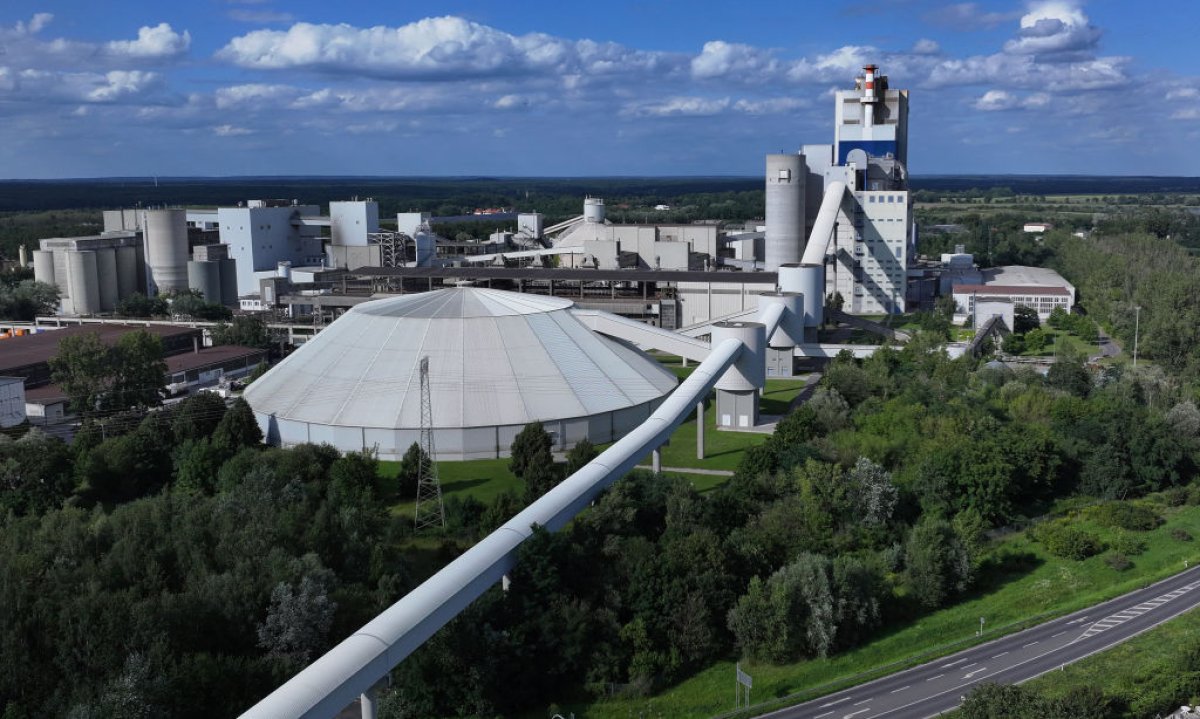As the planet heats up and catastrophic extreme weather events continue to increase, the search for new solutions to the climate crisis is growing ever more urgent. Few people are better positioned to find and nurture transformative new approaches than Evelyn Wang, who in January was sworn in as the new director of the the Advanced Research Projects Agency–Energy (ARPA-E).
Officially a part of the U.S. Department of Energy, ARPA-E's mandate is to promote and fund the research and development of high-risk, high-reward energy technologies. A key part of that mission is to support the development of cleaner energy sources and new technologies to reduce the level of greenhouse gases in the Earth's atmosphere.
Established in 2009, ARPA-E is modeled on the Pentagon's Defense Advanced Research Projects Agency (DARPA), which was created in 1957 to catalyze technological innovation in response to the Soviet launch of Sputnik 1. DARPA's mandate is to support "blue sky" military technologies in collaboration with academic, industry and government partners—ideas whose payoff is too far down the road, and too uncertain, for other funding sources. That 65-year-old agency, with a $4.1 billion annual budget, is credited with making key investments in weather satellites, GPS, drones, the personal computer, the Internet and the COVID-19 RNA vaccine, among other developments.

Wang, former chair of the Massachusetts Institute of Technology's Department of Mechanical Engineering, knows a thing or two about creating new technologies and bringing them to market. She invented a device that harvests clean drinking water from vapor in the air (even in arid conditions), a solar-powered desalination technology and a new type of thermal battery that could increase the range of electric vehicles by 40 percent, which she is developing in collaboration with Ford Motors.
ARPA-E, created 14 years ago to focus on energy technologies, currently has a $470 million budget—but it may increase to follow through on 458 other projects now in the pipeline. Wang spoke with Newsweek about some of the most promising projects and what they could mean for the climate-change crisis.
Newsweek: What is ARPA-E's role in fighting climate change?
Wang: We support a huge range of energy-related projects, all focused on completely new ways to generate, store and use energy. And as you know, the president has set a goal of reaching net-zero emissions by 2050. Obviously, energy plays a big role in thinking about how we can reach that goal.
We like to think of our agency as taking many shots on goal. We want to give policymakers options, and support technologies that will actually move the needle—pushing various sectors within the energy and climate space towards solutions that can work. One way to do that is to think about the key bottlenecks preventing solutions from taking root and then identify technological innovations that can help mitigate those bottlenecks.
What are some of those bottlenecks?
To take one item from the president's agenda, we know that methane emissions are significant in terms of greenhouse gases, up to 30 times worse than that of CO2 [carbon dioxide]. The bottleneck is how do you detect methane leaks for oil and gas infrastructure in an affordable way? When we started working on methane emission detection, the oil and gas industry said, "No, it's too expensive. It's just not something that we will do."
So we have supported companies working on sensitive and scalable technologies. We support a company called LongPath, which uses a new technology called "dual comb spectroscopy" to continuously monitor methane from oil and gas infrastructure. It does so at a cost level that the oil and gas industry will adopt. Another company called Bridger Photonics does a kind of flyover with LiDAR [Light Detection and Ranging, a kind of radar that bounces laser beams, rather than microwaves, off distant objects] and can map out the oil and gas infrastructure to identify leaks.
The oil and gas industry is now supporting these technologies because they realize the importance of it as we work towards ultimately everyone's goals of the net-zero emissions. Methane emissions are now something the whole industry has been talking about.
What are you doing to make the transition to clean energy sources?
We have a pretty large effort to electrify not only vehicle ground transport, but also aircraft. We know [air travel] has significant implications on CO2 emissions. If you have electric aircraft, you can reduce about 50 percent of fuel and emissions and also save 25 percent on operating costs.
Industrial decarbonization is another really big area that is also very important to us. Cement production, for instance, contributes to close to 10 percent of greenhouse gas emissions because it's so carbon intensive. We've been supporting various efforts to think about other ways to produce cement that is not so carbon-intensive and can even reach net-zero emissions. One company that we've been supporting, called Brimstone, uses calcium silicate rock instead of the typical type of material, which is very carbon-heavy. The process they use to create cement takes CO2 out of the atmosphere—it's actually a negative-emission cement process. It was recently certified as meeting international standards, which qualifies [the material] to be used in construction.
Has funding increased for ARPA-E under the Biden Administration?
The budget has been relatively steady in recent years, though it's increased since the start of the agency. We try to make the most out of our funding. Part of that is focusing on starting programs and supporting projects but, when things don't look promising, cutting them and using those resources to help support additional efforts. We're also starting to see the fruits of a lot of these projects, since it takes time. As people see the impacts they're having, hopefully that will make a difference.
We can also fund projects that are then able to take advantage of other funding sources. One example is in electric vehicles. We're supporting a company called Sila Nanotechnologies, which works on electrochemical batteries. They're trying to increase the energy density of their batteries by creating a silicon-based anode that replaces the graphite anode of a typical lithium-ion battery. And with that, you can increase the energy density by about 20 percent or more. What makes it really exciting is that they can take advantage of the infrastructure that exists for lithium-ion manufacturing, but still increase driving range.

This is already making a real-world difference. We started investing in the technology relatively early when it was more of a proof of concept. They've been able to scale up and demonstrate they can produce larger quantities of this material. They've now secured two automotive contracts, one of which is in Mercedes, and have gotten a significant follow-on funding, including from the bipartisan infrastructure law. They are using those funds to construct a 600,000-square-foot factory in Moses Lake, Washington, which will produce 20 gigawatt hours of batteries—enough to power about 200,000 EVs.
DARPA has famously taken credit for GPS and the Internet, among other things. What are some of the biggest successes that have come out of ARPA-E?
DARPA has been around for many decades. We are 14 years old. As we all know, energy technologies, especially hard tech, take time to mature and to be able to ultimately be deployed at scale. As we think about nearer-term successes, I already mentioned the one in the methane emissions space. Fusion is another area that we've invested in for about six, seven years now. There's still a lot of hurdles, but we've supported novel concepts dealing with plasma stability of the fusion core and other aspects of fusion. There's been some exciting progress, including the recent announcement from Livermore that they have demonstrated the possibility of getting more energy out than in with their laser-based fusion system.
A lot of people have been trying to create the spark of fusion. We support the fireplace, if you will—efforts a little further down the line to actually engineer systems and make them a reality. No one was talking about commercializing fusion when we started these programs. Now, many companies are working on commercializing fusion. We seeded those ideas and started initiatives and supported projects that have moved the needle towards realizing what is possible.
We've talked mainly about technologies to reduce emissions. Are we also going to need to find ways to remove CO2 from the atmosphere?
We have a pretty substantial agricultural portfolio. That includes technologies to help to reduce agricultural emissions, and increase the efficiency of biofuel. We also have an effort called Smart Farm, which grew out of the realization that there's an opportunity not only to reduce agricultural emissions, but also to use agriculture as a strong carbon capture tool. This is another area where it's important to identify what the bottlenecks are to adoption and try to address them. We know that by absorbing CO2 by the process of photosynthesis, crops can serve as great carbon sinks. The question is, how well are they actually doing that? And how effective can the soil, the roots and the crops actually be in sequestering carbon? And does that change over time?
The ability to measure and validate carbon release and capture is critical. Smart Farm supports technologies aimed at quantifying the release of CO2 and measure the ability of new types of crops to sequester carbon in the soil. These measurements can then be used to generate carbon credits, which will incentive farmers to use them. They can also see if they are increasing the efficiency of their production of these crops as well.
A company called Yard Stick has been quite successful. Traditionally, what people have done to understand how much carbon has been sunk into the soil is to take soil to a lab and then do the measurement there. Yard Stick developed a spectral, in-situ based approach to probe the soil. It can be lower cost, more efficient and now you can tell during the process of measuring how well you're doing. They just raised a $10.6 million series A round [of private financing], which we think is exciting because with everything that we develop and support, we want to sufficiently de-risk. The private sector will pick it up and invest and further mature it so that ultimately it can be deployed.
Have recent extreme weather events led to an increase in funding or affected your approach?
It speaks to the urgency and the need to keep on pushing and the need to continue to innovate in energy technologies. The devastation in Maui that just happened, for instance, highlights a need. One of the big challenges now is they have no working infrastructure. And of course, it's not just Maui. The infrastructure in Puerto Rico has taken a hit because of hurricanes.
We started a program recently called GOPHURRS [Grid Overhaul with Proactive, High-Speed Undergrounding for Reliability, Resilience, and Security]. The idea is that you need power for cities and for it to be resilient. We're looking to develop ways to [bury] the grid at a cost low enough to entice more locations to do it. Our cost target is 50 percent lower than current undergrounding practices. And that requires new sensing capability, being able to create the trenches that are necessary autonomously and do this in a way that can be cost effective.
These are the opportunities for us as an agency to ask how we can push the envelope so that these transformational approaches can be better, and lower cost, so that they can be deployed and help support the Americans that need them the most.
Correction (10/3/2023, 4:29 pm): A previous version of this article incorrectly reported the number of projects ARPA-E has in its pipeline. The correct number is 458 (the agency has had 1500 projects in its 14-year history).
About the writer
To read how Newsweek uses AI as a newsroom tool, Click here.



